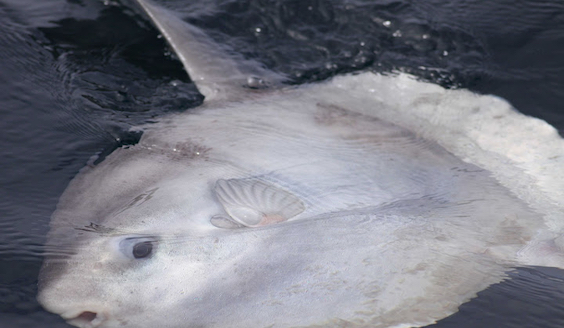Sunfish

The ocean sunfish or common mola (Mola mola) is one of the largest bony fish in the world. It was misidentified as the heaviest bony fish, which was actually a different species, Mola alexandrini. Adults typically weigh between 247 and 1,000 kg (545 and 2,205 lb). The species is native to tropical and temperate waters around the world. It resembles a fish head without a tail, and its main body is flattened laterally. Sunfish can be as tall as they are long when their dorsal and ventral fins are extended. Sunfish are generalist predators that consume largely small fish, fish larvae, squid, and crustaceans. Sea jellies and salps, once thought to be the primary prey of sunfish, make up only 15% of a sunfish’s diet. Females of the species can produce more eggs than any other known vertebrate, up to 300,000,000 at a time. Sunfish fry resemble miniature pufferfish, with large pectoral fins, a tail fin, and body spines uncharacteristic of adult sunfish. Adult sunfish are vulnerable to few natural predators, but sea lions, killer whales, and sharks will consume them. Sunfish are considered a delicacy in some parts of the world, including Japan, Korea, and Taiwan. In the European Union, regulations ban the sale of fish and fishery products derived from the family Molidae. Sunfish are frequently caught in gillnets.
A member of the order Tetraodontiformes, which also includes pufferfish, porcupinefish, and filefish, the sunfish shares many traits common to members of this order. The ocean sunfish, Mola mola, is the type species of the genus. Many of the sunfish’s various names allude themselves to its flattened shape. Its scientific name, mola, is Latin for “millstone”, which the fish resembles because of its grey colour, rough texture, and rounded body. Its common English name, sunfish, refers to the animal’s habit of sunbathing at the surface of the water. The caudal fin of the ocean sunfish is replaced by a rounded clavus, creating the body’s distinct truncated shape. The body is flattened laterally, giving it a long oval shape when seen head-on. The pectoral fins are small and fan-shaped, while the dorsal fin and the anal fin are lengthened, often making the fish as tall as it is long. Specimens up to 3.3 m (10 ft 10 in) in height have been recorded.
The mature ocean sunfish has an average length of 1.8 m (5 ft 11 in) and a fin-to-fin length of 2.5 m (8 ft 2 in). The weight of mature specimens can range from 247 to 1,000 kg (545 to 2,205 lb), but even larger individuals are not unheard of. The maximum size is up to 3.3 m (10 ft 10 in) in length, and maximum weight is 1320 kg (2910 lb
Ocean sunfish often swim near the surface, and their protruding dorsal fins are sometimes mistaken for those of sharks. However, the two can be distinguished by the motion of the fin. Unlike most fish, the sunfish swings its dorsal fin and anal fin in a characteristic sculling motion. southwestern coast to the Gulf Stream means that many of these sightings may also be the result of the fish being carried to Europe by the current.
Sunfish are most often found in water warmer than 10 °C (50 °F); prolonged periods spent in water at temperatures of 12 °C (54 °F) or lower can lead to disorientation and eventual death. Surface basking behaviour, in which a sunfish swims on its side, presenting its largest profile to the sun, may be a method of “thermally recharging” following dives into deeper, colder water in order to feed. Sightings of the fish in colder waters outside of its usual habitat, such as those southwest of England, may be evidence of increasing marine temperatures, although the proximity of England’s Sunfish are usually found alone, but occasionally in pairs.
The diet of the ocean sunfish was formerly thought to consist primarily of various jellyfish. However, genetic analysis reveals that sunfish are actually generalist predators that consume largely small fish, fish larvae, squid, and crustaceans, with jellyfish and salps making up only around 15% of the diet. Occasionally they will ingest eel grass. This range of food items indicates that the sunfish feeds at many levels, from the surface to deep water, and occasionally down to the seafloor in some areas. The mating practices of the ocean sunfish are poorly understood, but spawning areas have been suggested in the North Atlantic, South Atlantic, North Pacific, South Pacific, and Indian oceans. Females are estimated to be carrying as many as 300 million eggs, more than any other known vertebrate. Sunfish eggs are released into the water and externally fertilized by sperm.
Newly hatched sunfish larvae are only 2.5 mm (3⁄32 in) long and weigh less than one gram. They develop into fry, and those which survive can grow up to 60 million times their original weight before reaching adult proportions, arguably the most extreme size growth of any vertebrate animal.
If you would like to sponsor NCI St Ives and promote your business please CLICK HERE

© NCI St Ives 2013 -2025
The National Coastwatch Institution is a charity registered to save lives around our coast — No. 1159975
